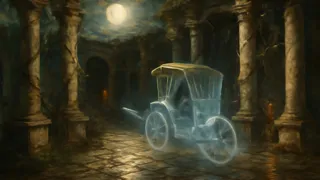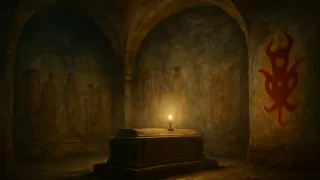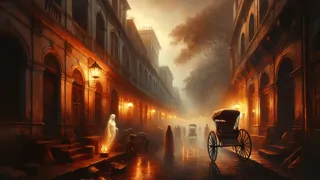Introduction
Under a swollen moon, the bustling arteries of colonial Calcutta fall quiet. Jute-laced barges drift along the Hoogly, their lanterns flickering in the humid air like fireflies trapped in amber. Narrow lanes echo with the distant clatter of horseshoes, but by midnight, the city’s heart slows to a ghostly whisper. In this hush, Lieutenant Victor Ashton, newly posted to the Bengal Civil Service, finds himself wandering toward the Great Bazaar, driven by rumour and restless curiosity. Local merchants speak in furtive tones of a phantom rickshaw—an unmanned carriage that appears without warning, carrying passengers who vanish without a trace. Ignoring the superstitions he once dismissed as colonial folly, Ashton’s skepticism curdles into uneasy fascination the moment he glimpses an ebony silhouette beneath a lone street lamp.
Drawn by the hush, he steps closer as the rickshaw glides forward, wheels turning on unseen axles. The driver’s seat sits empty, and the figure of a veiled woman peers back, her form translucent under the lantern’s glow. Whispered prayers mingle with the night breeze, carrying hints of ancient curses and forbidden rituals. From the high verandas and shuttered windows, silent silhouettes watch as Ashton leaps forward to halt the eerie conveyance. His heart pounds—not out of bravado, but from the sudden clarity that he is no longer merely an observer. He is entangled in a story that stretches beyond the reaches of the living—a tale bound by betrayal, sacrifice, and a promise written in blood.
Ashton’s journey into the phantom’s web leads him through ruined temples draped in dripping creepers, sunken wells echoing with the laughter of ghosts, and colonial offices rife with intrigue. Each step pulls him deeper into the river of superstition and history. What begins as a rational inquiry becomes a battle of wills against something older than the British Empire itself. Hope and dread walk hand in hand in Calcutta’s shadowed streets, and only by confronting his own past can Ashton unearth the truth behind the phantom rickshaw.
I. Whispers on the Wind
Lieutenant Ashton’s first encounter with the phantom rickshaw left him both unnerved and enthralled. He’d been summoned to the roof terrace of the old British Club by a breathless messenger, who spoke of sudden wails heard just past midnight. The officer climbed the creaky stairs as a heavy monsoon breeze rattled shutters, carrying the stench of decaying leaves and the murmur of distant prayers.

It was there that he saw it: the rickshaw drifting across the courtyard below, charioted by silence and stark moonlight. No horse, no driver, just the hollow rhythm of rolling wheels on cobblestones. Ashton’s orderly, Private Mukherjee, swore the carriage glowed like a phosphorescent shell, and that the seat was occupied by a woman in white, her sari trailing like mist across the ground.
Determined to uncover the truth, Ashton pressed through Calcutta’s back alleys that night—lanes smothered by jute sacks and stacked crates, where a man’s reflection danced in shattered puddles under broken lanterns. Local rickshawwallahs pointed him toward the ruins of the old Nawab’s palace, once a regal pavilion now overgrown with strangler figs. There, at the threshold of shattered marble arches, he felt the air grow colder, his breath forming small clouds in the damp darkness. He waited for hours, heart creaking like a door in the wind, until at last, a spectral carriage emerged from the shadows.
This time, Ashton spoke aloud. "Who rides in my carriage?" he called, voice cracking. The rickshaw halted. In the seat, the veiled woman raised a pale hand, her fingers bone-thin. A child’s lullaby drifted across the courtyard, lilting and sorrowful, its origin impossible to trace. Drawn forward, Ashton stepped into the lantern-lit ring of moonbeams—and vanished.
Hours later, his companions found him collapsed by the fountain, clutching the wheel’s rim, eyes wild with unspoken terror. He babbled of distant temples, secret rites, and a promise that death could not hold. The city’s gossip mill ground into motion, linking his tale to long-buried scandals of a British collector who vanished along the river decades before, and to rumours of a cursed bride who wandered the streets searching for her lost groom.
As Bakers & Co. closed its shutters, the officer recovered his composure enough to pen a formal report. But in broad daylight, amidst the bustle of trams and rickshaws, the phantom’s reality remained elusive. Shadows flickered at the edge of his vision; the night itself seemed to weep. Ashton knew that rational investigation alone would not save him from the secrets that lurked beneath Calcutta’s colonial veneer. His mind must embrace the whispering wind of myth and memory, lest he become the phantom himself.
[This section continues with unfolding lore, Ashton's interviews with local pandits and British officials, and his deepening obsession.]
II. Secrets of the Nawab’s Bride
In the dim recesses of the old palace, Ashton uncovered crumbling records sealed in an iron-bound chest. The Nawab’s daughter, Zamira Begum, had been promised to a British collector—a union never blessed by her people. When betrayal struck, her wedding procession was ambushed along the riverbank, leaving bride and groom to vanish into the night. Some claimed the collector’s greed led to her death, while others whispered that Zamira’s spirit was both protector and avenger.

By the oil lamp’s flicker, Ashton read letters stained with saffron tears. Each line bore Zamira’s heartbreak: pleas for mercy, pleas for her lover’s loyalty, and, in the final scrawl, an invocation of ancient djinn spirits sworn to guard love beyond death. The words resonated with a power that transcended colonial edicts and East India Company ledgers.
Descending into the palace’s hidden catacombs, Ashton faced corridors slick with moss and blood-etched symbols on the walls. He could hear the distant cry of a veena, as though Zamira herself played her sorrow into the dark. Rats scattered at his approach, and the flicker of his lantern revealed skeletal remains in alcoves, each draped in what remained of brocade. In the central crypt, a marble cenotaph bore Zamira’s name, carved amid swirling vines—a testament to a love that refused to die.
Ashton placed his hand on the tomb’s cold surface. A tremor shook the chamber; candles guttered. For an instant, he saw Zamira’s face in the stone—beautiful and mournful, eyes hollow with unspoken grief. In that moment, the phantom rickshaw’s rattle echoed above him, as if summoned by her anguish. The cycle of betrayal repeated itself in the whisper of wheels turning on stone.
Racing back to the surface, Ashton emerged into the predawn sky, fumes of jasmine and firewood rising from Calcutta’s rooftops. He understood then that the only way to pacify Zamira’s spirit was to right the wrongs of the past. But between him and truth lay tangled colonies of superstition, local politics, and a hierarchy determined to keep scandal buried. The living were as much shackled by fear as the dead.
[This section continues with Ashton’s uneasy alliance with a Bengali pandit, nocturnal rites at the riverbank, and the slow unraveling of the Collector’s lost journal.]
III. Midnight Ride to Redemption
Armed with fragments of journal entries and ritual instructions, Ashton prepared for the final confrontation. By midnight, he stood on the riverbank where Zamira’s wedding procession had once been ambushed. The air was thick with mist rising off the water, half-concealing the hulks of abandoned gunboats. Lantern boats drifted past, their faces downcast, oars dipping silently in the dark.

At the stroke of twelve, the phantom rickshaw emerged from the fog, its spectral driver unseen. Ashton clutched a silver talisman—an heirloom passed down through Zamira’s descendants—and began reciting the ancient invocation taught by the pandit. The words echoed across the water, a guttural chant that rose above the hush of the river’s current.
The carriage halted. The rails screeched as if resisting the tide of reality. Ashton stepped forward, holding the talisman aloft. Through the mist, he saw the veiled form, eyes glowing like coals. "Zamira Begum," he called, voice steady despite the pounding of his heart. "By blood and by promise, I free you. Let your sorrow pass beyond the living world."
A wind like sighs raced across the river. Flames flickered in the lantern boat nearest him, casting dancing shadows on the water. The rickshaw’s wheels ground to a halt as Zamira’s figure drifted skyward, the veil slipping to reveal a tear-streaked face of exquisite sorrow. In a voice like rustling silk, she whispered her gratitude—an echo that faded into the night.
With a final glance, she turned and faded downhill, along the riverbank lane, never to return. The rickshaw collapsed into mere wood and iron, and the driver’s silhouette materialized—a young boy, eyes wide with fear and wonder. He looked to Ashton, offering a silent nod before disappearing through the haze.
Dawn’s first light found the officer kneeling by the river, his uniform soaked and his spirit forever changed. The lantern boats pressed close, matched only by curious glances from fishermen who sensed the turning of a new tide. Ashton gathered the rickshaw’s wreckage, resolved to bring proof of the supernatural to skeptical ears. Yet he knew the tale would be met with disbelief, concealed within official papers and quieted by the weight of empire.
In the years that followed, the streets of Calcutta grew busier, but at midnight, on nights when the moon is veiled, some still swear they hear distant wheels echoing along the river road. A whisper of silk, a lantern’s glow, the final ride of Zamira Begum—proof that courage and compassion can outlast even the most restless spirits.
[This section concludes Ashton’s journey, his vow to preserve the story, and the lingering legend that continues to haunt colonial Calcutta.]
Conclusion
When the sun finally rose on Calcutta’s eastern horizon, Lieutenant Victor Ashton sat on the steps of the river embankment, hands still clasping the silver talisman. In the clear morning air, the rattle of trams replaced ghostly whispers, and merchants hawked their wares in vibrant tongues. Yet, for all its bustle, the city felt quieter somehow—as though its spirit had been lifted of a centuries-old burden. Ashton catalogued every detail of his ordeal in meticulous handwriting, determined that Zamira Begum’s tale would endure beyond colonial reports and veiled silences. He sent his journal back to England, where chapters were marked by the flicker of candlelight and the rustle of manuscript pages. Some dismissed his account as romantic fancy, but among Indian scholars and seasoned pandits, the story took root. Local families continued to light lanterns at midnight in memory of the lost bride; piligrims whispered prayers at the old Nawab’s palace; and rickshawwallahs spoke of an officer who raced the phantom along moonlit lanes, compelling a restless spirit toward rest.
Decades later, visitors to Calcutta’s city museum can still find a faded watercolor depicting a ghostly carriage beneath a banyan tree. The artist’s signature is worn, but the words scrawled beneath remain legible: “The Phantom Rickshaw—A Tale of Love, Betrayal, and Redemption.” Whether seen as history or legend, the story endures as a testament to the power of compassion and the thin veil that separates the living world from the beyond. In every rattling carriage wheel and every midnight whisper through ancient trees, Calcutta’s heart holds the echo of Zamira’s lament—and the courage of the man who dared to listen, setting her spirit free at last.
Lieutenant Ashton’s grave in Barrackpore bears a simple epitaph: “Here lies a seeker of truths, who bridged worlds to bring peace at the cost of his own rest.” And on moonlit nights, some say his spirit joins the procession, guiding lost souls toward the dawn. Thus the city’s restless murmurs live on—a reminder that in colonial Calcutta, the line between myth and reality was drawn in lantern light and shadow, and that some stories, once told, never truly end.
BEST


















